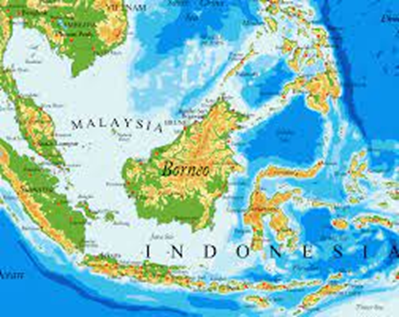
Indian Council of World Affairs
Sapru House, New DelhiBrunei Darussalam @40
New Year 2024 marked the fortieth anniversary of the independence of Brunei Darussalam as a British Protectorate. Within a week, the anniversary of Brunei Darussalam joining the Association of Southeast Asian Nations (ASEAN) community was also marked.
This nation, with an area of 5,765 sq. km (2,226 sq. mi) and with a population of 484,991 (2023 est.)[i] joined the ASEAN fold on January 7, 1984, as the sixth member of this regional forum was unique. What makes the inclusion of Brunei unique is not only the weeks’ time lag between Bandar Seri Begawan gaining its sovereignty and joining the Southeast Asian regional forum but also the road that lay behind it.
From Konfrontasi to ASEAN
Brunei, located on Borneo Island, sandwiched between East Malaysia/ Malaysian Borneo was proposed to have become a part of the Malaysian Federation when the latter gained its independence from Britain in 1963. Being a hereditary Sultanate, it was proposed that Brunei would be at par with the other Sultanates of Malaysia and join the new federation’s rotational Head of State system.
However, this proposal set in motion an undeclared low-intensity confrontation between Indonesia, which had gained its independence from the Dutch in 1949, and the Federation of Malaysia. This low-intensity clash between Indonesia and Malaysia, which came to be known as Konfrontasi was a period between January 1963 to August 1966.
The crux of the dispute was that the British Malaya as it stood before 1957 referred only to the Sultanates in what is now Western or Peninsular Malaysia. However, in the run-up to its independence in 1963, Malaya was first incorporated into the British Commonwealth on August 31, 1957, as a federated member. The Federation of Malaysia incorporated eastern Malaysia or Peninsular Malaysia as well as the then-British crown colonies of North Borneo, Sarawak, and Singapore.
Map I: Locating Borneo Island
Source: Google Images: Borneo, World Atlas, https://worldatlas.com/islands/borneo.html.
For Indonesia, its bone of contention arose as the Borneo region that was in the Federation of Malaysia was part of what Indonesia calls the Kalimantan region. Even today about two-thirds of this region, Kalimantan or Borneo, is an integral part of the world's largest archipelago nation. However, in the late 1950s and early 1960s, Indonesia believed that the whole of Borneo should rightfully become a part of its territory and the incorporation of Sarawak, Sabah and Brunei, which made the northern part of the island with Malaysia was unacceptable. In this regard, it was the Sultanate of Brunei that became a contested space and not Sarawak and Sabah.
The announcement that Malaysia would gain its independence in August 1963 marked the beginning of the Konfrontasi as this declaration by Britain marked the death knell of any diplomatic or political solution. At the same time, sections within Brunei had their reservations with respect to joining Malaysia and desired to remain outside the federation, which also played its part in the low-level conflict of brinkmanship.
Map II: Brunei Darussalam
Source: Google Images: Borneo, Sketch Bubble, https://www.sketchbubble.com/en/presentation-borneo-map.html.
Konfrontasi, a low-intensity conflict at its core also represented the complex political and then-evolving landscape in the region in the colonial and post-colonial world. Additionally, Indonesia as a champion of the Non-Alignment Movement (NAM), with its socialist-leaning was seen as an anathema to the monarchical state of Malaysia that was in the making.
This impasse was resolved by developments within Indonesia that finally saw President Sukarno being replaced by Suharto in Mach 1967. Subsequently, after the change in guard in Indonesia, the Association of Southeast Asian Nations (ASEAN) came into existence on August 8, 1967, which consolidated the post-Sukarno peace. The formation of ASEAN and its basic principles of amity, cooperation and non-interference came to reinforce the cessation of hostilities that Konfrontasi came to be associated with.
The subsequent independence and the accession of Brunei into the ASEAN fold in January 1984 was at a time when this regional organisation was seen as a bulwark against communism. It was this geopolitical landscape of Southeast Asia that was instrumental in shaping both ASEAN’s internal cohesion and Brunei's external outlook.
Brunei since Independence
Since independence, the Sultanate’s foreign policy has been based on and guided by the principles of the ASEAN Charter. Resultantly, the country, despite being a party to the South China Sea maritime territorial dispute has maintained a non-confrontational approach to this issue as well as other outstanding issues. Instead, Brunei Darussalam has maintained an approach of quiet diplomacy or silent engagement with all other countries.
It has been this attitude that has facilitated Brunei to maintain a harmonious relationship with several countries. This is evident from the fact that out of the total population of 485,000 (2023 est.), immigrants make up approximately 26% (2019).[ii] This population is also multiethnic with Malay constituting 67.4%, Chinese at 9.6%, and others at 23% (2021 est.).[iii] What is of note here is that the others, who constitute 23% of the population include those who are not from the immediate neighbourhood of the Sultanate. For instance, Indians who number approximately 15,000 or around about 3% of the population are also included.[iv]
This tapestry of social cohesion, which encompasses both natives and immigrants has been the hallmark of Brunei. One of the reasons that can be attributed to this social cohesion is the structure of the economy is predominantly dependent on oil and natural gas, which has given it an economic windfall. This in turn has been translated into a robust welfare system with the majority of the population being employed in the public sector. Apart from this, the Brunei Investment Agency (BIA), manages an estimated about 40% of Brunei's foreign reserves in the form of portfolio investments in several commercial ventures across the world for many years now. This portfolio investment by the BIA has also assisted the Sultanate in absorbing periodic economic shocks.
It is this approach of Brunei that was also reflected when Bandar Seri Begawan as Chair of ASEAN that the Five-Point Consensus (5PC) adopted by the regional forum as a means to address the delicate political and security landscape of Myanmar after the military coup of February 1, 2021. While the 5PC had not been welcomed by Myanmar with open arms, the efforts by the Sultanate in steering regional forums’ engagement with the junta were noteworthy.
Brunei- India and the Indo-Pacific
What also makes the silent diplomatic approach of Brunei more relevant in the larger context of the Indo-Pacific is that the Sultanate is one of the few nations’ whose external engagement has been by and large trouble-free in this evolving theatre of geopolitics. The role of Brunei, especially in light of its geographic location in Southeast Asia gains additional importance as the Sultanate can become a stabilising factor in the Indo-Pacific region.
It is also for this very reason that Brunei is important for India, especially in the light of New Delhi’s Act East Policy and Indo-Pacific approach. Brunei has actively participated in a number ASEAN- Indian initiatives including port calls by Indian Navy vessels, joint training and participating in each other’s DefExpo. However, with the changing geo-economic landscape in the Indo-Pacific region, the prospects for deeper engagement are evident. The spheres of such economic engagement between Brunei and India are not only limited to the oil and natural gas sectors where the Sultanate has proven expertise but also attracting strategic investments from the Brunei Investment Agency into India. Though the nature of trade ties is limited to a narrow list of items of trade, India has been one of the largest importers of energy from the Sultanate.[v]
The impact of such a strategic investment would not only deepen ties but also provide additional cover for the Sultanate's economy to absorb periodical shocks. For India, on the other hand, to deepen ties with Brunei would give New Delhi greater credibility and manoeuvrability in the Indo-Pacific theatre. And this with a country that has had more than benevolent ties with all countries in the larger Indo-Pacific region would be only to India’s advantage.
*****
*Dr. Sripathi Narayanan, Research Fellow, Indian Council of World Affairs, New Delhi.
The views expressed are personal.
[i] Brunei Country Summary, CIA World Fact Book, https://www.cia.gov/the-world-factbook/countries/brunei/summaries/ accessed on January 10, 2024.
[ii] Ibid.
[iii] Ibid.
[iv] INDIA - BRUNEI BILATERAL RELATIONS, High Commission of India, Brunei Darussalam, December 26, 2023, https://www.hcindiabrunei.gov.in/page/india-brunei-bilateral/, accessed on January 10, 2024.
[v] Ibid.















